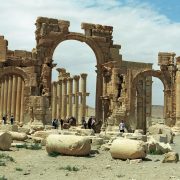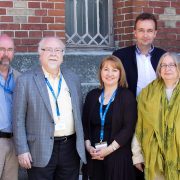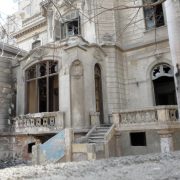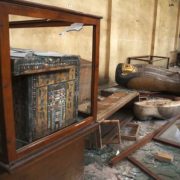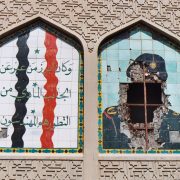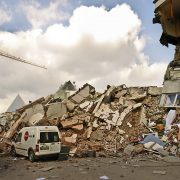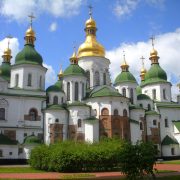Statement – Palmyra
Blue Shield International udsendte den 22. april 2016 følgende erklæring om Palmyra. I erklæringen anbefaler Blue Shield organisationen en række nødvendige foranstaltninger, der bør tages nu og her. Desuden opfordres der til, at man allerede nu begynder, at udforme en handlingsplan for bevaring af kulturværdier i Syrien, så man kan gå i gang med det samme, når den væbnede konflikt er overstået:
Palmyra and the wider historic environment in Syria 22 April , 2016
1.0 We can only welcome the removal of Da’esh from the World Heritage Site of Palmyra and the initial analysis that, while extensive, damage has been less widespread than previously feared. The international heritage community must now support and stand together with Syrian colleagues to work to stabilise the site and prepare it for the future.
2.0 We must, however, accept the fact that the site continues to sit within a conflict zone and that it would be premature, and insensitive, to make final decisions as to its future. While there is a clear urgency to stabilise and protect the site, wider international efforts must be directed surely to the peaceful resolution of, and to the humanitarian support for those affected and displaced by, the conflict. It must be accepted that Palmyra’s recapture does not mean the end of the war is significantly closer.
3.0 Now is the time to plan
3.1 The above does not mean that there should be no action: quite the contrary. However, the temptation to take rapid decisions and actions that current and future generations may regret should be avoided. We need to work together to support Syrian stakeholders (including academics, archaeologists, heritage managers, local communities, tourism agencies etc.) who must lead the development of plans for the most suitable future for the site and for all cultural property as defined by the 1954 Convention. This will require the full documentation of the site (if not already available) as a base-line record. In particular, the opportunities and methodologies relating to the full or partial reconstruction of those parts of the site damaged and destroyed by Da’esh needs to be discussed, as does how this most recent, appalling chapter in the site’s history is to be memorialised and included in the interpretation of the palimpsest of the site’s past.
3.2 As a World Heritage Site Palmyra should be contributing to UNESCO’s over-arching objective of creating a culture of peace in the world. It is currently difficult to imagine, but at some point in the future the site could, some might say must, be deployed as a reflective vehicle for reconciliation and peace, not only for all Syrians but for all people.
4.0 Immediate necessary action
4.1 While there has been significant international media interest in the condition of the site, access to it now needs to be controlled and it treated as, effectively, a ‘crime scene’. No clearing up or other action should take place until: • A competent authority has declared the terrain clear of explosive devices and unexploded ordnance • The necessary evidence of the Da’esh-controlled period has been collected • All pieces of damaged objects from the museum have been carefully mapped and collected • All damage to the site since the beginning of hostilities, and in particular the remains of monuments destroyed by Da’esh, have been mapped to facilitate and ensure that any potential re-construction might be as authentic as possible if so desired • An assessment of any immediate necessary structural stabilisation has been made • Recent mass graves have been investigated and cleared or dealt with appropriately
4.2 While some or many of these actions may have been completed or are underway, led by the Syrian Department of Antiquities (DGAM), any additional international support required needs to be identified, requested, and organised.
5.0 The wider context
5.1 Palmyra is an iconic, internationally renowned and hugely important, site: hence its World Heritage status. It is however, a relatively straightforward site to deal with once decisions have been made about its future. It is a clearly defined, clearly bounded, heritage monument with little modern intrusion within the boundaries of the World Heritage Site.
5.2 More problematic is the future management of the whole of the urban historic environment in Syria including, for example, the centres of Aleppo and Homs and of all cultural property as defined by the 1954 Convention. It is clear that there will be, very understandably, enormous pressure following the end of the conflict to rebuild the urban centres in Syria most affected as quickly as possible. In the past, there has been a wide-ranging response in different parts of the world facing similar situations – from the wholesale reconstruction of parts of cities such as Warsaw and Dresden; to the bulldozing away of historic, bomb-damaged urban centre to be replaced by modern architecture – as happened in most British urban centres following the Second World War; to the widespread destruction following more recent conflict, of the historic architecture and below ground archaeology of cities such as Beirut. While those in Syria plan for this restoration (and we understand initial restoration work has already taken place at Krak des Chevaliers and in old Homs), a number of projects are being planned already regarding this urban reconstruction led by a variety of disparate, well-meaning international groups. The reasons for these different approaches in the past, and the different projects currently being planned, need to be understood and coordinated. Colleagues and communities in Syria must lead the debate on which approach should be taken but they will need, without question, considerable international support to be able to mitigate what will be undoubtedly highly persuasive and lucrative arguments for rapid, modern redevelopment.
6.0 Recommendations a) that, where action has not been taken already, the actions identified in 4.1 above be immediately led by Syrian colleagues with the support of the international community where and when additional expertise is necessary and practical b) that, as soon as appropriate, an international conference (possibly informed by specialised workshops) be held in the MENA region facilitated if requested by the Blue Shield, if possible in conjunction with UNESCO, but driven by Syrian colleagues, to discuss and begin to develop a robust, strategic plan for post-conflict heritage management in Syria. In particular decisions around methodologies and practices of reconstruction following the end of hostilities, both on archaeological sites and in urban centres, must be made and their existence made known to those national and international bodies and organisations helping with the search for a peaceful resolution to the current conflict.
Se den originale erklæring: Blue Shield reflections on Palmyra.


